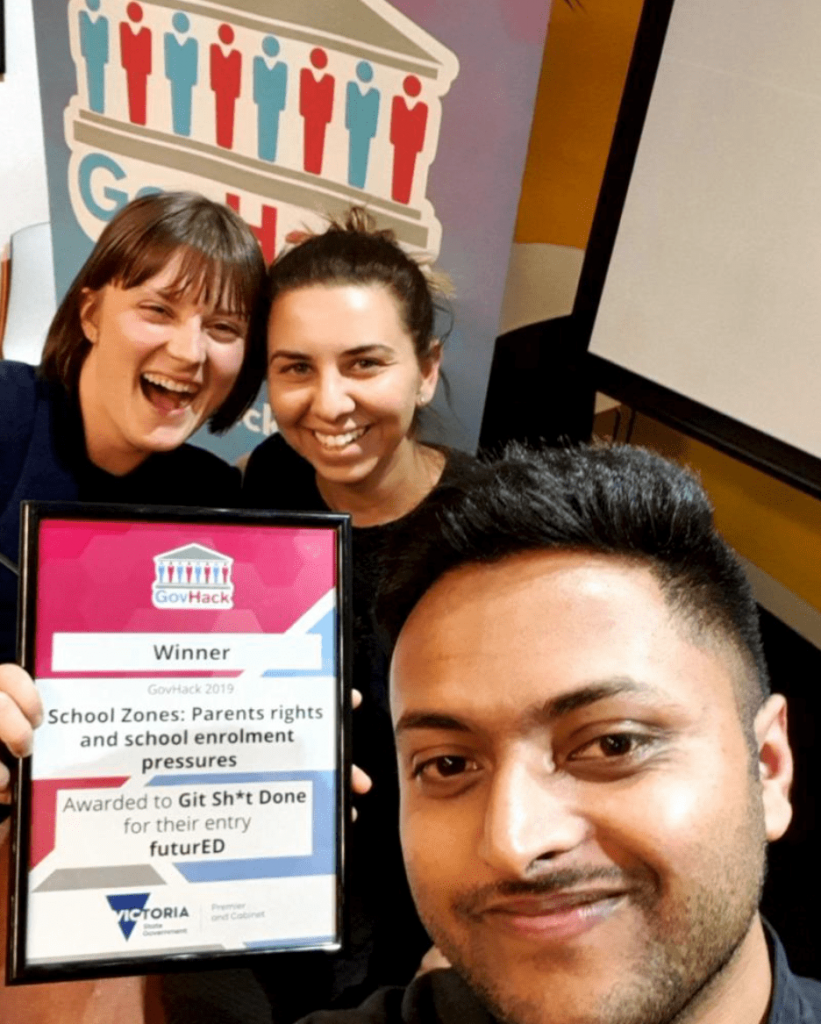GovHack is an international competition for people of all abilities who seek to make life better through open data. Across one weekend, thousands come together to form teams, agree on projects, and participate in what has become one of the world’s largest open data competitions.
Having never participated in a hackathon before, our initial assumption was a 48 hour sprint where people work together and eat pizza. We caught a whiff of the GovHack competition on Friday at work drinks, moments before the opening night, and then spontaneously decided to register and participate.
For that one weekend, we all worked remotely at our own respective homes, and tried to pull something together for the submission.
This is our story….

The Challenge
“In Victoria, all children are entitled to be enrolled at their designated neighbourhood school as a right under the legislation. How can we help parents understand their rights and schools manage their enrolment pressure.”
- Eligibility: The use of any dataset featured on data.vic, or data accessed through developer.vic.gov.au Entries that cross reference Victorian government data with other sources will score highly.
- Entry: Challenge entry is available to all teams in Australia.
Our Solution:
What was the problem?
Our interpretation of this challenge was that parents have to make a significant decision on the education of their children based on a number of different sources. Currently, schools rely on posters to promote open days and rely on paper forms for new enrolments.
Families don’t always know where schools are located, which hinders the reach that schools could gain. Paper forms are a highly manual and time consuming task for families to fill out, and likewise for schools having to aggregate the data.
Lastly, it sparks an environmental issue, which we can easily solve with technology.
We understood this problem as well as other factors such as the importance of location and distance, modes of transport and how much would it cost to live in the same school zone.
How did we solve it?
We knew there was a trend where parents were willing to move house to be in an area that enabled their child to be eligible for schools. The problem is that parents need to do copious amounts of research to know about these school zones, and know which schools would be right for their child. The existing tools for this problem are all siloed, making it hard to get the right information.
futurED automatically brings all these resources together with a single search, then provides a deeper context and value on distance and transport options, housing prices and reviews from the community.
Using data sets that featured Victorian schools coupled with property sales and rental statistics, we were able to display context for parents who were considering moving home to get into the right school zone.
The morning drop off and afternoon pickup is a daily task for parents, which is why we incorporated data sets from Public Transport Victoria and Google Maps in our solution. Each school features an estimate of how long it would take to walk, cycle, use public transport, or drive, giving parents a more holistic approach of a school.

How did we work?
Based on external commitments and the location of team members, working remotely was going to work best.
We used the standard methods of communication – phone calls, WhatsApp, and Slack – over the two day period. We had regular check-ins over the weekend where tasks could be delivered, reviewed or set. These served as mini-milestones, helping us remain on track throughout the weekend
To manage individual tasks we used Trello. For the implementation of the tasks themselves, we used Premier Pro for video editing, Figma for design and prototyping and Google Sheets for data. We all felt comfortable using these tools as we were already familiar with them.
What went well?
Understanding the problem space is what we believed helped us come up with a solution to the GovHack challenge. Team mates had similar experience in the domain of choosing a school and were prepared to move house in order to do so. As there was a real life example, having a Subject Matter Expert (SME) meant that we could cover some use cases that were inline with the problem space and help tie the challenge and open datasets together.
Each team member bought their own set of unique skills, with the same mindset and goals. Each personality was willing to contribute and had the confidence to voice their opinion. The culture was not to work overtime, simply choosing one challenge to complete and timebox. We documented our progress along the way with a collaborative approach, enabling us to make decisions quickly.
What did we learn?
We surprised ourselves to say the least, just by the sheer amount of deliverables we managed to get done in two days time, with eight hours of sleep per day. It was mostly because of the type of team we had. Everyone had their part to play and brought their best skills to play. We were efficient and productive. We learnt the power of having the right people in the team (ie. quantity vs quality).
The other important learning from our hackathon experience was to always stick to the problem we set out to solve. We could’ve easily gone in tangents but then we kept asking the question, is this solving the problem?
The last thing we would want to touch on in terms of learning is the amount of open data available for public consumption. There is a wide range of data from train schedules to museum contents, which helped us meet the challenge brief with our solution.
Full project details of futurED can be found on GovHack Hackerspace.







